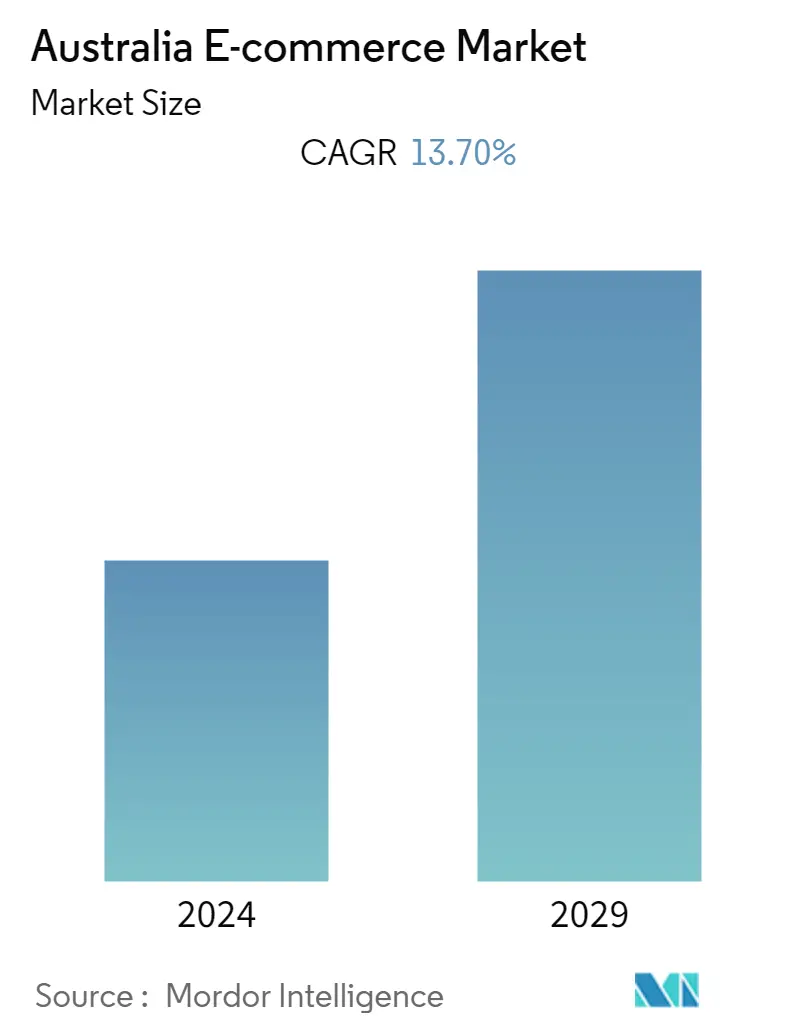Market Size of Australia E-commerce Industry

| Study Period | 2019 - 2029 |
| Base Year For Estimation | 2023 |
| Forecast Data Period | 2024 - 2029 |
| Historical Data Period | 2019 - 2022 |
| CAGR | 13.70 % |
| Market Concentration | Low |
Major Players
*Disclaimer: Major Players sorted in no particular order |
Australia E-commerce Market Analysis
The Australia E-commerce market is expected to register a CAGR of 13.7% during the period 2022-2027. The Australia E-commerce market is primarily driven by the strong internet penetration, shoppers' confidence, and comfort with buying online in the country.
- Australia is closer to where many of the global E-commerce leaders were pre-pandemic but still lags in purchase frequency. However, in the past few years, online spending and high-frequency buying have gained momentum in the region, which is expected to drive the market in the coming years.
- Moreover, consumer behavior and confidence in online purchasing are further driving the market in the region. E-commerce players in the region need to know every detail of their products and provide thorough information, supported by images, video, or virtual reality, to attract consumers. A variety of payment options, competitive shipping, and a range of delivery choices also provide customers with the flexibility they're seeking.
- According to Australia Post, 48.8% of all online payments are made via PayPal. Debit and credit cards account for 39.9% of online payments. The fastest-growing segment is the buy now pay later market, accounting for 6.7% of online transactions. The most well-known provider in this segment is AfterPay.
- Mobile commerce represents a major opportunity in the Australia E-commerce market. With mobile penetration close to 100%, mobile payments and purchasing are effective strategies for all E-commerce players. As per a recent report by PayPal, 26.4% of all E-commerce transactions occur via mobile phone, representing a 28.8% year-on-year increase and dwarfing transactions made over laptops and desktops, which have been shrinking over the last couple of years.
- E-commerce market players need to face the challenge of embedding sustainable practices that span the entire supply chain from product development right through to recycling options at the product's end of life. Many retailers are taking innovative approaches to this, including Designerex, a peer-to-peer designer clothing rental service, which is working to reduce the impact of fast fashion and facilitate a circular economy.
- The COVID-19 pandemic has brought a permanent shift in consumer buying behavior from in-store to online shopping, which has accelerated the E-commerce market in the region. The convenience brought by E-Commerce through home deliveries is expected to gain popularity, reach broader audiences, and increase sales for retailers in the years to come.
Australia E-commerce Industry Segmentation
E-commerce or electronic commerce refers to buying and selling goods and/or services via electronic channels such as the internet through smartphones, laptops, and tablets. E-commerce has emerged as a popular choice for purchasing goods and services online in Australia over the past few years.
The Australia E-commerce Market is Segmented into B2C E-commerce (Beauty and Personal Care, Consumer Electronics, Fashion and Apparel, Food and Beverage, Furniture and Home), and B2B E-commerce.
| By B2C E-commerce | ||||||||
| Market Size (GMV) for the Period of 2017-2027 | ||||||||
|
| By B2B E-commerce | |
| Market Size for the Period of 2017-2027 |
Australia E-commerce Market Size Summary
The Australian e-commerce market is experiencing robust growth, driven by factors such as high internet penetration, increased consumer confidence, and the convenience of online shopping. The market is evolving rapidly, with a significant shift in consumer behavior towards online purchasing, a trend accelerated by the COVID-19 pandemic. This shift has led to a surge in online spending and a rise in the frequency of purchases, although Australia still lags behind some global leaders in this regard. The market is characterized by a diverse range of payment options, competitive shipping, and flexible delivery choices, which are crucial in attracting and retaining consumers. Mobile commerce is particularly promising, with a substantial portion of transactions occurring via mobile devices, highlighting the importance of mobile-friendly platforms for e-commerce players.
The fashion and apparel segment is poised for significant growth, fueled by increased sales in athleisure and footwear, as well as strategic participation in major sales events. The market is also witnessing a growing demand for sustainable products, driven by environmentally conscious consumers, particularly among the younger demographic. This trend is encouraging retailers to adopt sustainable practices, thereby enhancing their appeal and market share. The competitive landscape is fragmented, with major players like eBay Australia, Amazon, and Kogan.com actively expanding their operations and forming strategic partnerships. Innovations such as Pinterest's partnership with WooCommerce and Amazon's new sort center in Melbourne are indicative of the dynamic nature of the market, which is expected to continue its upward trajectory over the forecast period.
Australia E-commerce Market Size - Table of Contents
-
1. MARKET INSIGHTS
-
1.1 Market Overview
-
1.2 Industry Attractiveness - Porter's Five Forces Analysis
-
1.2.1 Bargaining Power of Suppliers
-
1.2.2 Bargaining Power of Buyers/Consumers
-
1.2.3 Threat of New Entrants
-
1.2.4 Threat of Substitute Products
-
1.2.5 Intensity of Competitive Rivalry
-
-
1.3 Key Market Trends and Share of E-commerce of Total Retail Sector
-
1.4 Impact of COVID-19 on the E-commerce Sales
-
-
2. MARKET SEGMENTATION
-
2.1 By B2C E-commerce
-
2.1.1 Market Size (GMV) for the Period of 2017-2027
-
2.1.2 Market Segmentation - by Application
-
2.1.2.1 Beauty and Personal Care
-
2.1.2.2 Consumer Electronics
-
2.1.2.3 Fashion and Apparel
-
2.1.2.4 Food and Beverages
-
2.1.2.5 Furniture and Home
-
2.1.2.6 Others (Toys, DIY, Media, etc.)
-
-
-
2.2 By B2B E-commerce
-
2.2.1 Market Size for the Period of 2017-2027
-
-
Australia E-commerce Market Size FAQs
What is the current Australia E-commerce Market size?
The Australia E-commerce Market is projected to register a CAGR of 13.70% during the forecast period (2024-2029)
Who are the key players in Australia E-commerce Market?
eBay Australia Pty Ltd, Amazon Commercial Services Pty Limited, Kogan.com, Woolworths and Coles are the major companies operating in the Australia E-commerce Market.

